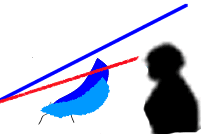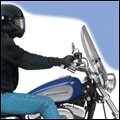|
|
||
|
Generally, this means that a correctly sized windshield mounted to your bike will have a top edge that is horizontally level with the tip of your nose ,or just slightly below eye level. Low sporty screens are great for fair weather, but for larger screens, it is important to get a screen that fits the driver as well as the bike Other Considerations When Choosing a Windshield Size |
||
2. Your Height and How Tall You Sit in the Saddle Two six-foot tall riders may see the world equally when standing, but differently when seated on their bikes. Some riders are all legs, some are all torso, and some are /. Plus, riders with longer arms on the handgrips will carry their heads higher than those with shorter arms. Sitting on your own bike, letting the front and rear suspension settle from your weight, and getting a normal, relaxed grip on the bars is the best way to get started. Customisations and aftermarket accessories may affect the riding position, so it is essential to take all these modifications into account. Have a friend handy to help measure things while you maintain your normal riding posture. A tape measure and a yardstick (or any long straightedge) will be the required tools. Measure the distance from the point horizontally level with your nose to the point where the windshield measurement begins, as indicated in the specifications for each of our windshield products. Alternatively, place something on the ground approximately feet in front of your bike. When seated on your bike, you should be able to view the object comfortably looking over the screen. •Handlebar Mounted Windshields, like the Deflector Screen™ and Street Shield™, have their height measured from the absolute top to the absolute bottom along the surface angle of the shield. Width is measured horizontally across the back of the shield at the widest point (illustration 1).•Fork Mounted Cruiser Windshields, like the SwitchBlade®, Spartan®, Heavy Duty™ and Dakota™, have their height measured from the top of the headlight cutout to the top edge along the surface angle of the shield. Note: The top of the headlight cutout is typically 2-3 inches above the top of your headlight shell, so begin at that point and measure upward in a straight line parallel to the rake angle of the forks. Width is measured horizontally across the back of the shield at the widest point (illustration 2). •Metric Sport Touring Windscreens, like our fairing mounted and fork mounted VStream® Windscreens, are measured from the bottom center point of the screen and straight along the surface angle of the screen to the top edge. Width is measured horizontally across the back of the screen at the widest point (illustration 3). Note: Some VStream Windscreens, like the models for the Suzuki M and M9R, have a great deal of setback and top edge curvature. These windscreens are measured similarly to (illustration 6), using the fixed point of the headlight cowl's top edge as the baseline for height measurement. •V-Twin Fairing Mounted Touring Windscreens, like theFLH/FLT VStream®, are measured from the bottom center mount point to the top of the screen (illustration 4). FLH/FLT Wave® Windscreens are measured differently. Here, the height is measured from the top of the OEM fairing's windscreen channel straight up vertically to a point horizontally level with the top of the screen. Width is measured horizontally across the back of the screen at the widest point (illustration 5). •Specialty Windshields, like the Stinger™ Quick Release Windshields, are measured from a designated point at the bottom of the shield (in this case, the headlight) and vertically straight up to a point horizontally level with the top edge of the shield (illustration 6). Other specialty windshields, like the Plexifairing3™, Plexistar2, Flyscreen® and F-Series™ Fairings are measured measured as described for (illustration 3). 3. You and Your Riding Style The type of riding (commuting, touring, etc.) you most often do and the level of wind blast you are comfortable with are the final determining factors in your windshield decision. Year-round, any-weather riders and long-distance tourers will be best served with a large screen offering ample wind protection. Commuters, cruisers, and warm weather riders will find a mid-size or smaller screen sufficient for their needs. Riders who want it both ways will find the right solution in either a quick-release windshield or two different sizes of the same shield that can be easily changed when required. |
||
4) For bikes with Manual or Electric lowering and raising mechanisms, it is important to realise the effect of the change of windshield  angle when the screen is not fully raised. In the case of the VStream screens, the angle is slightly more acute when the screen is not fully raised and may cause more buffeting at high speeds. The screen should be horizontally level with the tip of your nose ,or just slightly below eye level, when the screen is fully raised. For this reason, it is NOT recommended that shorter riders should fit the very tall screens and use them at a lower height. angle when the screen is not fully raised. In the case of the VStream screens, the angle is slightly more acute when the screen is not fully raised and may cause more buffeting at high speeds. The screen should be horizontally level with the tip of your nose ,or just slightly below eye level, when the screen is fully raised. For this reason, it is NOT recommended that shorter riders should fit the very tall screens and use them at a lower height.See the illustration on the right- this screen is slightly too tall for this rider! and lowering the screen will increase the likelihood of buffeting at speed. NOTE: In some European countries it is a legal requirement that the driver should be able to see over the screen, if not, a windshield wiper should be fitted.( Not a good look for your bike!!) |
||

